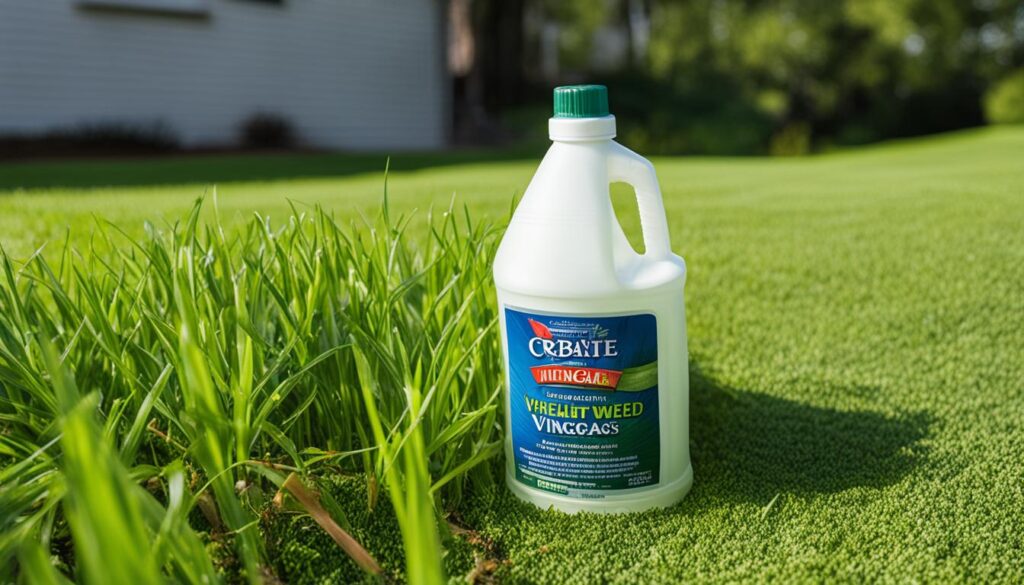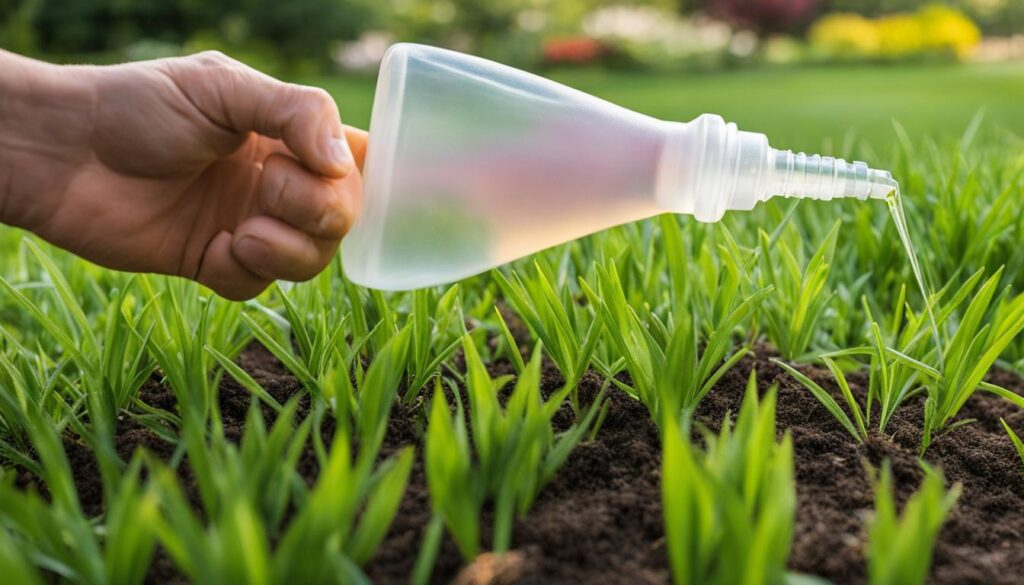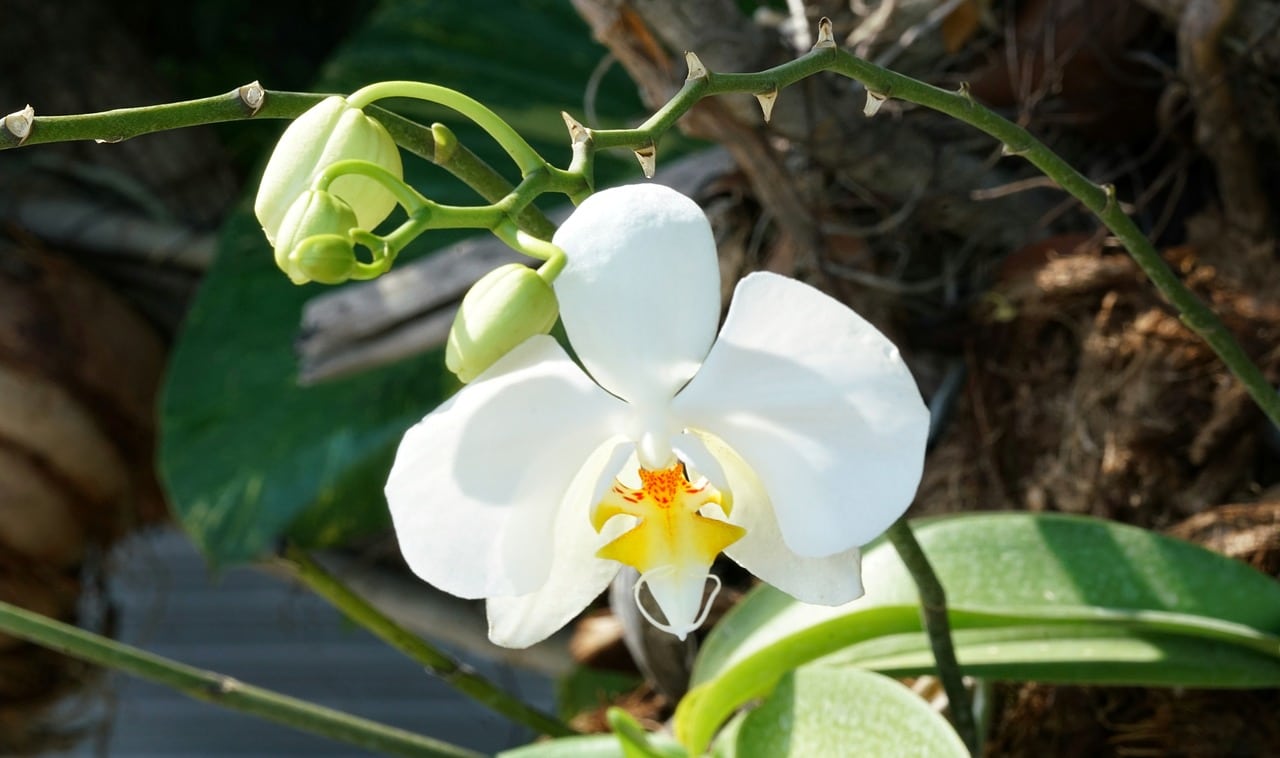Are you struggling with crabgrass taking over your lawn? If you’re searching for a natural and effective solution, vinegar might be the answer you’ve been looking for. Researchers from the U.S. Department of Agriculture (USDA) have confirmed that vinegar, containing about 5 percent acetic acid, can effectively kill crabgrass. In fact, vinegar solutions with higher concentrations of acetic acid are even more potent in eliminating this pesky weed.
Post Summary
- Vinegar, with its acetic acid content, can kill crabgrass effectively.
- Higher concentrations of acetic acid in vinegar make it an even more powerful weed killer.
- Directly spraying vinegar on crabgrass and repeating the application over time leads to optimal results.
- Vinegar is a safe and environmentally friendly option for weed control.
- By using vinegar, you can eliminate crabgrass without resorting to chemical herbicides.
What is Crabgrass?
Crabgrass, also known as Digitaria sanguinalis and Digitaria ischaemum, is an annual weed that is native to Europe or Eurasia but was introduced to the United States in 1849. As an annual weed, it completes its lifecycle within a single year. Crabgrass is commonly found in thin and bare spots in lawns, thriving in hot and dry conditions. Its low-growing stems radiate out from the center, resembling crab legs, hence its name. This grassy weed can produce thousands of seeds, which can stay viable in the soil for multiple years, contributing to its ability to spread rapidly.
Table 2 provides a visual representation of the key characteristics of crabgrass compared to other types of grassy weeds.
| Characteristic | Crabgrass | Other Grassy Weeds |
|---|---|---|
| Growth Habits | Low-growing stems radiating from the center | Vary depending on the specific weed species |
| Native Origin | Europe or Eurasia | Vary depending on the specific weed species |
| Introduction to US | Introduced in 1849 | Vary depending on the specific weed species |
| Growth Conditions | Thrives in hot and dry conditions | Vary depending on the specific weed species |
| Seeding Behavior | Produces thousands of seeds | Vary depending on the specific weed species |
“Crabgrass, with its low-growing stems resembling crab legs, is an annual grassy weed that can quickly take over lawns if not controlled properly.”
Understanding the characteristics and growth habits of crabgrass is crucial for effective weed control. By identifying and implementing the appropriate prevention and elimination methods, you can keep your lawn free from this annoying and invasive weed.
How Does Crabgrass Spread?
Crabgrass, like many other weeds, spreads through its prolific seed production and dispersal. Each crabgrass plant can produce an astonishing number of approximately 150,000 seeds. These seeds have the ability to remain viable in the soil for several years, making it easy for them to germinate and establish new plants. The germination process typically occurs in the following spring, when the conditions are optimal for growth.
To further complicate matters, crabgrass seeds have the ability to spread easily through various means. They can be dispersed by wind, animals, or even through inadvertent human activities such as mowing or walking on the grass. This is why crabgrass can quickly take over lawns if not kept in check.
In order to prevent crabgrass from spreading and taking hold in your lawn, it is crucial to implement effective weed control measures. By understanding the seed dispersal mechanisms of crabgrass and taking proactive steps to inhibit germination, you can effectively combat this invasive weed and maintain a healthy, pristine lawn.
Methods of Crabgrass Seed Control
There are several strategies you can employ to prevent crabgrass seeds from germinating and spreading. These methods include:
- Regularly mowing your lawn to prevent seed heads from forming and dispersing seeds.
- Implementing proper watering techniques to ensure your lawn receives sufficient moisture without creating the ideal conditions for crabgrass germination.
- Applying pre-emergent herbicides specifically formulated to target crabgrass seeds before they have a chance to germinate.
- Practicing good lawn maintenance, such as aerating and overseeding, to promote the growth of healthy grass that can outcompete crabgrass.
By combining these strategies and staying vigilant in your weed control efforts, you can effectively curb the spread of crabgrass and maintain a beautiful, weed-free lawn.
| Methods | Effectiveness | Pros | Cons |
|---|---|---|---|
| Regular mowing | Low | Easy to implement | Does not prevent germination entirely |
| Proper watering | Moderate | Essential for overall lawn health | Requires careful monitoring |
| Pre-emergent herbicides | High | Effective at preventing germination | Timing is crucial for optimal results |
| Good lawn maintenance | High | Encourages healthy grass growth | Requires ongoing effort and care |
Preventing Crabgrass
Preventing crabgrass requires a proactive approach to lawn care and implementing effective weed control measures. By following these tips, you can minimize the growth of crabgrass and maintain a healthy lawn.
Soil Test
Start by getting a soil test to identify any underlying issues with your lawn. This will help you determine the pH level, nutrient deficiencies, and other factors that may contribute to crabgrass growth. By addressing these issues, you can create an environment that is less favorable for crabgrass.
Lawn Care Practices
- Proper irrigation: Water deeply and infrequently to encourage deep root growth in your grass, making it more competitive against crabgrass.
- Mowing height: Set your mower to a higher cutting height, as taller grass shades the soil, preventing crabgrass seeds from germinating.
- Fertilization: Avoid over-fertilizing your lawn, as this can promote the growth of crabgrass. Instead, follow the recommended fertilization schedule for your specific grass type.
Seeding and Overseeding
Seeding your lawn in late summer or early fall with cool-season grasses can give them a competitive advantage over crabgrass. Cool-season grasses, such as Kentucky bluegrass and tall fescue, thrive in cooler temperatures and outcompete crabgrass during its peak growth period. Overseeding your lawn annually can also help fill in bare spots and prevent crabgrass from taking hold.
Crabgrass Prevention Techniques
| Technique | Description |
|---|---|
| Proper irrigation | Water deeply and infrequently to encourage deep root growth in your grass, making it more competitive against crabgrass. |
| Mowing height | Set your mower to a higher cutting height, as taller grass shades the soil, preventing crabgrass seeds from germinating. |
| Fertilization | Avoid over-fertilizing your lawn, as this can promote the growth of crabgrass. Follow the recommended fertilization schedule for your specific grass type. |
| Seeding and overseeding | Seed your lawn in late summer or early fall with cool-season grasses, such as Kentucky bluegrass and tall fescue, to outcompete crabgrass. Overseed annually to fill in bare spots. |
By implementing these preventive measures and maintaining a healthy lawn, you can significantly reduce the occurrence of crabgrass and enjoy a lush, weed-free lawn.
Using Vinegar to Kill Crabgrass
If you’re looking for a natural and effective way to get rid of crabgrass, vinegar can be a powerful ally. Vinegar contains acetic acid, which is a natural weed killer. It’s a safe and environmentally friendly alternative to chemical herbicides. When using vinegar to kill crabgrass, it’s important to follow the proper application techniques to maximize its effectiveness.
Start by mixing vinegar with water to create a solution with about 5 percent acetic acid concentration. You can use white vinegar or apple cider vinegar. Fill a spray bottle with the vinegar solution and spray it directly onto the crabgrass. Make sure to thoroughly coat the leaves and stems of the crabgrass. Repeat this process over a few days to a couple of weeks until the crabgrass dies.
The Vinegar and Salt Weed Killer Method
Here’s a step-by-step guide on using vinegar and salt as a weed killer:
- Mix equal parts vinegar and salt in a spray bottle. For example, you can use 1 cup of vinegar and 1 cup of salt.
- Shake the spray bottle vigorously to ensure that the salt is dissolved in the vinegar.
- Spray the mixture directly onto the leaves of the crabgrass, being careful to avoid any desirable plants.
- Repeat the application as needed, keeping in mind that multiple applications may be necessary for larger or more stubborn crabgrass patches.
By using vinegar and salt as a weed killer, you can effectively eliminate crabgrass and other unwanted weeds from your lawn or garden. Just remember to use caution and apply the mixture only to the targeted plants, as excessive salt can have detrimental effects on the surrounding soil and other desirable plants. With proper application and regular maintenance, you can enjoy a weed-free outdoor space that is both beautiful and healthy.
Other Natural Crabgrass Killer Recipes
If vinegar and salt are not the right fit for your weed-killing needs, don’t worry. There are several other natural recipes that you can try to effectively get rid of crabgrass from your lawn or garden. These alternatives provide organic and eco-friendly solutions to help you maintain a weed-free outdoor space.
Boiling Water
One simple and effective method is to pour boiling water directly onto the crabgrass plants. The high temperature of the water will scorch and kill the weeds. However, be careful when using this method as boiling water can also harm desirable plants and grass if not applied with caution. This method is best suited for spot treatments and small areas.
Hand Pulling or Tools
If you prefer a more hands-on approach, you can manually pull out the crabgrass or use hand tools such as a trowel or weed puller. This method requires patience and persistence, as you need to ensure that you remove the entire root system of the crabgrass to prevent regrowth. It is advisable to pull the weeds when the soil is moist to make the process easier.
Corn Gluten
Another natural pre-emergent herbicide is corn gluten meal. This by-product of the corn milling process inhibits crabgrass seed germination by releasing natural compounds. Apply corn gluten meal in early spring, before the crabgrass seeds germinate. Follow the recommended application rates and ensure that it is well watered after application to activate its weed-suppressing properties.
Vinegar and Dish Detergent
You can also try a mixture of white vinegar or apple cider vinegar with a few drops of dish detergent. The vinegar acts as a weed killer, while the dish detergent helps the solution stick to the leaves of the crabgrass. Spray the mixture directly onto the weed, ensuring thorough coverage. Repeat the application as necessary until the crabgrass is eliminated.
These natural crabgrass killer recipes provide you with a range of options to choose from based on your preferences and the size of the infestation. Experiment with different methods to find the one that works best for your lawn or garden. Remember to always follow the instructions carefully and consider professional assistance if needed.
| Method | Pros | Cons |
|---|---|---|
| Boiling Water | – Simple and effective – Organic and eco-friendly |
– May harm desirable plants if not applied carefully – Best suited for spot treatments and small areas |
| Hand Pulling or Tools | – Direct and hands-on approach – No chemicals involved |
– Requires patience and persistence – Labor-intensive for larger areas |
| Corn Gluten | – Natural pre-emergent herbicide – Safe for the environment |
– Best applied before crabgrass seed germination – May affect other germinating plant seeds |
| Vinegar and Dish Detergent | – Effective weed killer – Common household ingredients |
– May require repeated applications – Can affect desirable plants if not applied carefully |
Pros and Cons of Using Vinegar as a Weed Killer
When it comes to natural weed control, vinegar is often hailed as a miracle solution. However, like any other method, there are pros and cons to using vinegar as a weed killer. Understanding these can help you make an informed decision about whether vinegar is the right choice for your weed control needs.
Pros of Vinegar Weed Killer
- Vinegar is an inexpensive option for weed control. It is readily available and affordable, making it a cost-effective solution for many homeowners.
- Using vinegar as a weed killer is environmentally safe. It does not contain harmful chemicals that can leach into the soil or pose a risk to human health.
- Vinegar is effective against certain weed species. It can kill many common weeds, including crabgrass, dandelions, and chickweed.
Cons of Vinegar Weed Killer
- Vinegar may damage desirable plants if not applied carefully. It is a non-selective herbicide, meaning it can harm any plant it comes into contact with.
- Vinegar does not kill the roots of weeds. It only kills the foliage, so repeated applications may be necessary for perennial weeds.
- While vinegar is effective against certain weed species, it may not be as effective against others. Some weeds may require stronger chemical herbicides for complete eradication.
Before using vinegar as a weed killer, it’s important to weigh these pros and cons. Consider the specific weeds you are dealing with, the potential impact on desirable plants, and your overall weed control goals. It may also be beneficial to explore alternative natural weed control methods or seek professional assistance for long-term solutions.
Natural Weed Control Methods
When it comes to maintaining a lush and healthy lawn or garden, weed control is essential. While chemical herbicides are commonly used, they can pose health risks and have negative environmental impacts. Fortunately, there are several natural weed control methods that can effectively prevent weed growth and maintain the beauty of your outdoor space.
Organic Gardening
One of the key strategies for natural weed control is practicing organic gardening. This approach focuses on building and maintaining healthy soil, which in turn promotes strong and robust plants that can better compete with weeds. Organic gardening involves techniques such as composting, mulching, and using organic fertilizers. By creating a nutrient-rich and well-balanced soil environment, you can prevent weed seeds from germinating and establish a strong foundation for the growth of desirable plants.
Preventing Weed Growth
Another important aspect of natural weed control is preventing weed growth in the first place. Regularly monitoring your lawn or garden for weeds and taking swift action can help prevent them from becoming a major problem. Hand-pulling weeds as soon as they appear can be an effective method, especially for small infestations. Additionally, using mulch can provide a physical barrier that inhibits weed germination and helps retain soil moisture. It is important to choose a mulch that is free from weed seeds and apply it at a sufficient thickness to smother weed growth.
| Benefits of Natural Weed Control Methods | Drawbacks of Natural Weed Control Methods |
|---|---|
|
|
“Natural weed control methods, such as organic gardening and preventing weed growth, offer a safe and sustainable approach to maintaining a weed-free outdoor space.”
By implementing natural weed control methods, you can create a healthier and more sustainable environment for your lawn or garden. These methods not only prevent weed growth but also promote overall plant health and contribute to a vibrant and beautiful outdoor space. Whether you choose organic gardening techniques, regular monitoring, or a combination of strategies, natural weed control can help you achieve the weed-free landscape you desire.
Avoiding Chemical Herbicides
If you are concerned about the health risks and environmental impact of chemical herbicides, there are plenty of eco-friendly options available. Using natural weed control methods, such as vinegar, salt, and manual removal, can be just as effective in eliminating crabgrass without the harmful effects. By avoiding chemical herbicides, you can promote a healthier and more sustainable environment for your lawn and garden.
Benefits of Avoiding Chemical Herbicides
Avoiding chemical herbicides offers numerous advantages. Firstly, it reduces the risk of exposure to toxic chemicals for both you and your family. Chemical herbicides can have harmful effects on human health, such as skin irritation, respiratory problems, and even potential links to cancer. By opting for eco-friendly options, you can ensure a safer environment for everyone.
Secondly, avoiding chemical herbicides helps protect beneficial insects and wildlife. These chemicals can have detrimental effects on pollinators like bees and butterflies, as well as other beneficial insects in your garden. When you choose natural weed control methods, you create a more balanced ecosystem that supports biodiversity and promotes a healthier environment.
Eco-Friendly Alternatives
There are several eco-friendly options to consider when it comes to weed control. Vinegar, for instance, is a natural herbicide that can effectively kill crabgrass and other weeds. It is easy to use and readily available, making it a convenient choice for many gardeners. Additionally, salt can be used in combination with vinegar to create a more potent weed killer, although it should be used sparingly to avoid soil damage.
Manual removal is another effective and environmentally friendly approach. Simply pulling out crabgrass by hand or with a tool can be a time-intensive but highly targeted method of weed control. It allows you to remove the entire plant, including its roots, preventing regrowth and reducing the need for chemical intervention.
| Eco-Friendly Weed Control Methods | Advantages |
|---|---|
| Vinegar | – Safe for the environment – Cost-effective – Easy to use |
| Salt and vinegar mixture | – Increased effectiveness – Long-lasting removal |
| Manual removal | – Targeted approach – Prevents regrowth – Reduces chemical use |
By incorporating these eco-friendly alternatives into your weed control routine, you can maintain a beautiful and thriving lawn or garden without resorting to chemical herbicides. It’s a responsible choice that benefits both your immediate surroundings and the wider environment.
Professional Weed Control Services
While DIY methods can be effective in controlling crabgrass, sometimes you may need the expertise and assistance of professional weed control services. These professionals specialize in eliminating crabgrass and other invasive weeds, providing long-term solutions tailored to your specific needs. By hiring a professional, you can save valuable time and effort while ensuring the health and beauty of your outdoor space.
Professional weed control services have in-depth knowledge of weed biology, growth patterns, and effective control methods. They also have access to professional-grade equipment and herbicides that can effectively target and eliminate crabgrass without harming desirable plants. With expert assistance, you can rest assured that your weed problems will be addressed efficiently and effectively.
In addition to crabgrass control, professional weed control services can also provide recommendations and ongoing maintenance plans to prevent future weed growth. They can advise you on proper lawn care practices, such as regular mowing, watering, and fertilization, which can help keep your lawn healthy and weed-free. With their knowledge and experience, they can help you achieve a beautiful and thriving outdoor space.
| Benefits of Professional Weed Control Services | Drawbacks of Professional Weed Control Services |
|---|---|
|
|
Overall, professional weed control services can be a valuable investment for homeowners seeking long-term solutions and a weed-free outdoor space. If DIY methods are not providing the desired results or if you prefer to leave the task to experts, consider hiring a professional weed control service to ensure your lawn remains healthy and vibrant.
Conclusion
In conclusion, vinegar is an effective and natural solution for controlling crabgrass. Its acetic acid content can kill crabgrass, and higher concentrations provide even better control. By spraying vinegar directly on the crabgrass and repeating the application over a few days to a couple of weeks, you can effectively eradicate this pesky weed. Vinegar is not only safe to use but also environmentally friendly, making it a great alternative to chemical weed killers.
Along with vinegar, there are other natural methods to control crabgrass and maintain a healthy lawn or garden. Proper lawn care practices, such as regular mowing and watering, can help prevent crabgrass growth. Applying mulch and manually removing weeds are also effective methods. By incorporating these natural weed control methods into your routine, you can keep crabgrass at bay and enjoy a beautiful outdoor space.
It’s important to note that vinegar serves as a temporary solution for crabgrass control, as it only kills the above-ground parts of the weed. To ensure long-term control, consider combining vinegar applications with other preventive measures. Additionally, if you need expert assistance or are dealing with a severe crabgrass problem, you may want to consider hiring a professional weed control service. Their expertise and long-term solutions can help you maintain a healthy and crabgrass-free lawn or garden.
Can Vinegar be Used to Kill Blackberry Bushes as Well?
Yes, vinegar can be used for killing blackberry bushes naturally. The acetic acid in vinegar is an effective weed killer and can help eliminate invasive blackberry bushes without using harmful chemicals. Simply spray the vinegar directly onto the leaves and stems of the blackberry bushes to kill them.
FAQ
Will vinegar kill crabgrass?
Yes, vinegar can effectively kill crabgrass. Vinegar solutions containing about 5 percent acetic acid are particularly effective. Higher concentrations of acetic acid provide even better control.
What is crabgrass?
Crabgrass is an annual weed native to Europe or Eurasia that was introduced to the United States in 1849. It grows in thin and bare spots in lawns and can produce thousands of seeds. It thrives in hot and dry conditions and has low-growing stems that resemble crab legs.
How does crabgrass spread?
Crabgrass spreads through seed dispersal. Each crabgrass plant can produce approximately 150,000 seeds, which can stay viable in the soil for multiple years. The seeds germinate in the following spring and create new plants, easily taking over lawns if not controlled properly.
How can I prevent crabgrass?
To prevent crabgrass, start by getting a soil test to determine if there are any underlying issues with your lawn. Proper irrigation, mowing, and fertilization practices can also help. Seeding your lawn with cool-season grasses in late summer or early fall can give them a competitive advantage over crabgrass.
How can I use vinegar to kill crabgrass?
Vinegar, especially those containing about 5 percent acetic acid, can effectively kill crabgrass. Spray the vinegar directly on the crabgrass, repeating the application over a few days to a couple of weeks until the crabgrass dies.
Can vinegar and salt be used as a weed killer for crabgrass?
Yes, mixing vinegar with salt can create a more potent weed killer. The salt helps to dry out the root system of the crabgrass, leading to longer-lasting removal. However, excessive use of salt can make the soil inhospitable for future plant growth.
Are there other natural recipes to kill crabgrass?
Yes, other natural methods include using boiling water, pulling out the crabgrass by hand or with a tool, applying corn gluten as a natural pre-emergent herbicide, and using a mixture of vinegar with dish detergent.
What are the pros and cons of using vinegar as a weed killer?
Vinegar is inexpensive, environmentally safe, and effective against certain weed species. However, it can potentially damage desirable plants if not applied carefully. It also does not kill the roots of weeds and may require repeated applications for perennial weeds.
What are other natural weed control methods?
Other natural weed control methods include maintaining a healthy lawn through proper mowing, watering, and fertilization practices, using mulch to suppress weed growth, and manually pulling out weeds.
How can I avoid using chemical herbicides?
If you’re concerned about the health risks and environmental impact of chemical herbicides, there are plenty of eco-friendly options available. Using natural weed control methods like vinegar, salt, and manual removal can be just as effective in eliminating crabgrass without the harmful effects.
Should I consider hiring a professional weed control service?
If DIY methods are not providing the desired results, you may consider hiring a professional weed control service. These professionals have experience and expertise in effectively eliminating crabgrass and other invasive weeds. They can provide long-term solutions and personalized recommendations based on the specific needs of your lawn or garden.
How effective is vinegar in killing crabgrass?
Vinegar can indeed kill crabgrass effectively and safely. It is a natural and environmentally friendly alternative to chemical weed killers. By using vinegar and other natural weed control methods, you can maintain a healthy and weed-free lawn or garden without compromising your health or the environment.












